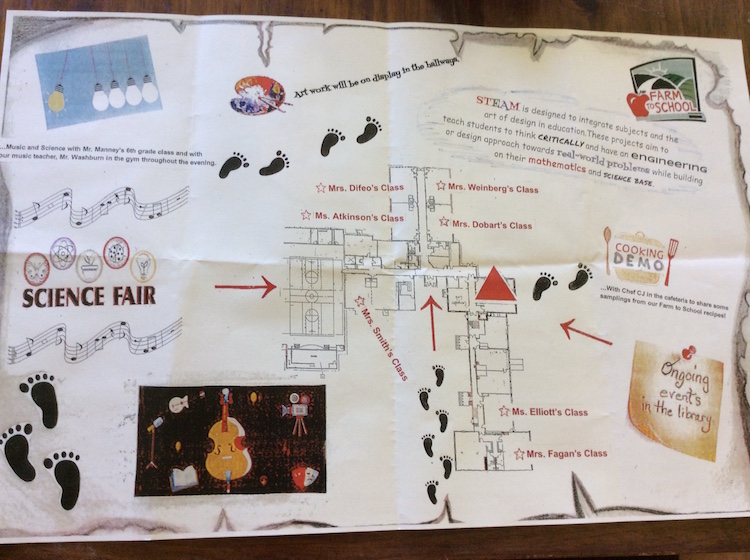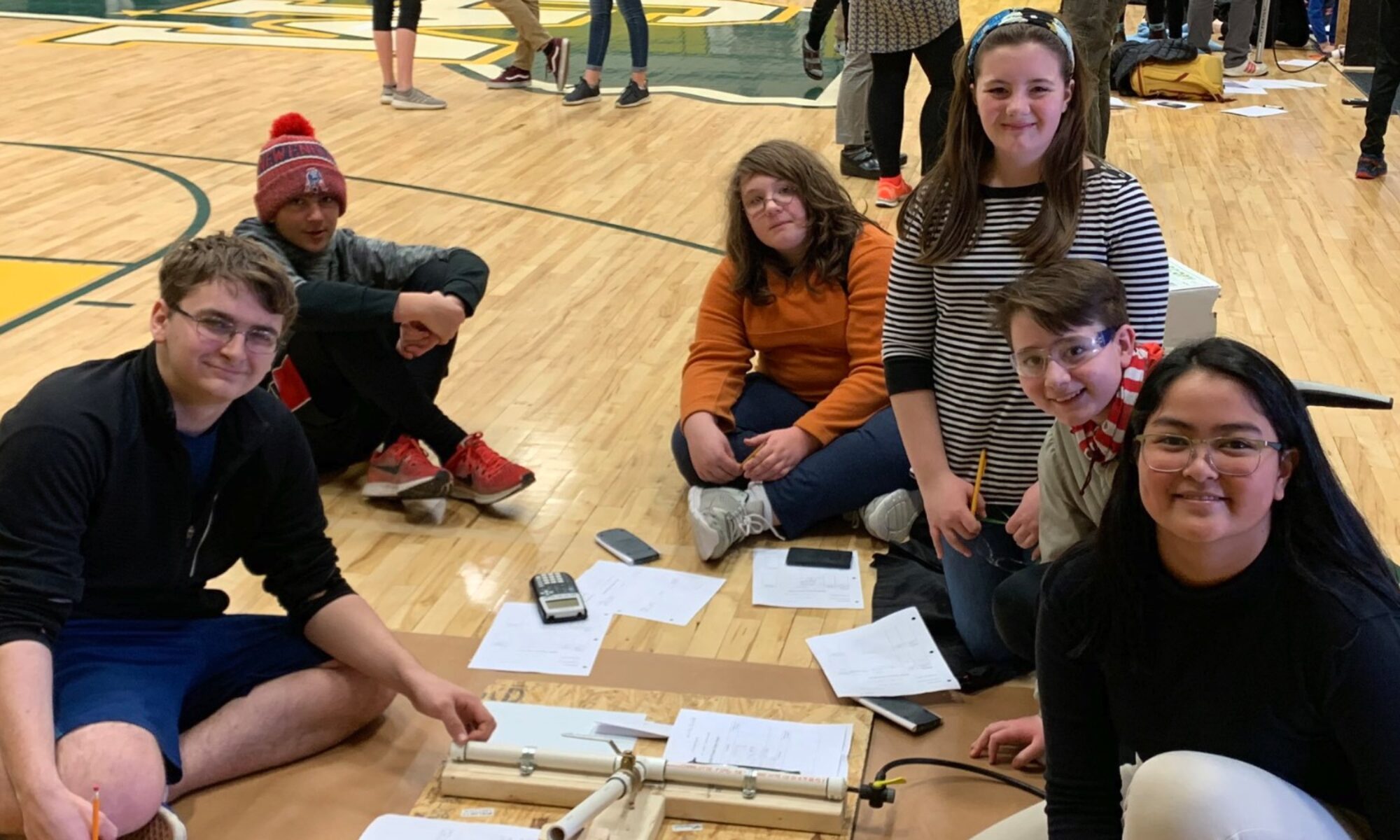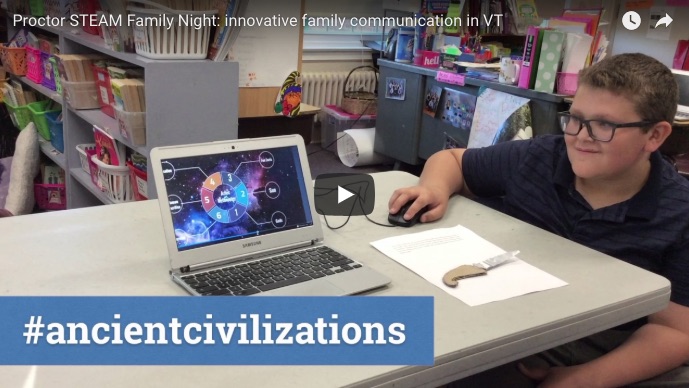Proctor’s STEAM Family Night
 The sleepy little town of Proctor VT, is making some big waves when it comes to showcasing their students’ STEAM achievements. STEAM (Science, Technology, Engineering, Arts & Math) is a hot topic in school innovation right now, and rural towns like Proctor are primed and ready to show their communities just why STEAM matters so much to students.
The sleepy little town of Proctor VT, is making some big waves when it comes to showcasing their students’ STEAM achievements. STEAM (Science, Technology, Engineering, Arts & Math) is a hot topic in school innovation right now, and rural towns like Proctor are primed and ready to show their communities just why STEAM matters so much to students.
How do you explain STEAM & PBL to families?

Proctor Elementary School sits near the very top of this tiny town’s mountainous terrain. Home to 145 students in grades PreK-6 and a host of compassionate and driven educators, Proctor Elementary has been busy! The school just finished a full year of implementing tech-rich, student-centered project-based learning and doing. They installed a makerspace, complete with 3D-printer, Makey-Makeys, coding robots and a video production space. They supported students in pursuing studies of invasive species, dynamic light and sound, cooking and nutrition and ancient civilizations.
Now the only question was how best to show off all this hard work to the community.
Principal Christy Coloutti explains, “We had a staff discussion about all these great projects that had been happening all year long through project-based learning, and we thought: What are we going to do to celebrate this?”
“We had a Google Doc and we were sharing ideas for quite some time, actually, debating,” continues Coloutti. “And all the teachers and students gave their ideas, as to what they wanted to happen that evening.”
Welcome to Proctor’s STEAM Family Night
On June 1, 2017, the school threw wide its doors to families and community members for a STEAM Family Night. And the community showed up in droves, many streaming down a quiet nearby street on foot, passing under dappled trees to reach Proctor Elementary’s welcoming entrance.
Visitors entering the school were given a snazzy, annotated map. It guided them to both the events and the demonstrations on display around the school. The map also made clear Proctor Elementary’s guidelines for STEAM learning:
STEAM is designed to integrate subjects and the art of design in education. These projects aim to teach students to think CRITICALLY and have an ENGINEERING or design approach towards real-world problems while building on their MATHEMATICS and SCIENCE BASE.

Families and community members milled through Proctor Elementary’s light-filled hallways, enjoying the early evening June sunshine almost as much as the vibrant, constant display of student art. Many families settled in the cafeteria to enjoy the event’s band- and choral interludes.
The “Art” in STEAM was on constant display at the event.
It ran from a collection of ceramic monsters on windowsills to the crowd-pleasing songs and dances. All the way through to the pairing of traditional diorama constructions with slideshows on Chromebooks.
These pairings showcased a project-based learning unit focused on ancient civilizations. In Courtney Elliott’s 4th-grade class, students chose one aspect of the Aztec civilization to study and constructed a real-world artifact to go along with their Prezi or Google Slides.

One student studied Aztec construction and engineering methods and built a model of a traditional Aztec dwelling. When asked how he chose the topic, he replied, “My dad and my family are in building and construction. So I thought they might like it.”
…And so was the engineering.
Over in the school’s makerspace, students demonstrated how they were using the 3D printer to create various sizes of model tractor tires. In the library, a group of students shared how they were coding robotic mice to learn algorithms. Younger students presented motor cars made out of Legos. A display of cardboard pinbox machines illustrating math principles had been laid out with care.
[huge_it_slider id=”15″]
What made Proctor’s STEAM Family Exhibition so successful?
In a word: family.

Principal Coloutti again. “One of the things I loved was that most of the classrooms had activities that people could engage in, which I thought was very important. We had our makerspace open, we had our library open and families were completing activities together. I think that’s a big part of the evening. It’s to really come together as families.”
And this school is a family.
“All the other kids were able to interact with each other,” continues Coloutti. “Typically, our 6th grade Science Fair has been for 6th graders and their parents. But here the whole school got to walk through. And I think because the kids had so much in participating in the activities, that their families really wanted to do that.”
As a result, every grade was represented at the exhibition.
Everyone had something to share. Every family was welcome in each classroom, and students happily explained their work to everyone they met. Additionally, this whole-school sharing schema gave younger students the opportunity to see the types of STEAM projects they could take on in the coming year.
How do you share the stories of STEAM projects with families?



One Reply to “Sharing STEAM projects with families”
Comments are closed.